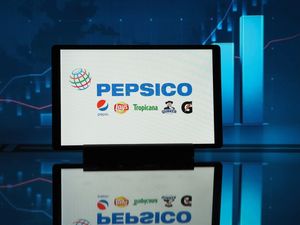
Nvidia’s Q2 results aligned with Wall Street’s expectations, reflecting continued demand for the company’s data center and AI platforms. Management attributed the quarter’s performance to strong adoption of the Blackwell architecture, a seamless transition to next-generation hardware, and broad-based growth across cloud, enterprise, and sovereign AI customers. CFO Colette Kress highlighted, “Factory builds in late July and early August were successfully converted to support the GV300 ramp... full production is underway.” The company also noted increased demand for Hopper and H200 GPUs, supporting diverse AI workloads and reinforcing the value of its CUDA software ecosystem.
Is now the time to buy NVDA? Find out in our full research report (it’s free).
Nvidia (NVDA) Q2 CY2025 Highlights:
- Revenue: $46.74 billion vs analyst estimates of $46.52 billion (55.6% year-on-year growth, in line)
- Adjusted EPS: $1.05 vs analyst estimates of $1.01 (4.1% beat)
- Adjusted EBITDA: $30.83 billion vs analyst estimates of $27.58 billion (66% margin, 11.8% beat)
- Revenue Guidance for Q3 CY2025 is $54 billion at the midpoint, roughly in line with what analysts were expecting
- Operating Margin: 60.8%, down from 62.1% in the same quarter last year
- Inventory Days Outstanding: 106, up from 59 in the previous quarter
- Market Capitalization: $4.15 trillion
While we enjoy listening to the management's commentary, our favorite part of earnings calls are the analyst questions. Those are unscripted and can often highlight topics that management teams would rather avoid or topics where the answer is complicated. Here is what has caught our attention.
Our Top 5 Analyst Questions From Nvidia’s Q2 Earnings Call
- C.J. Muse (Cantor Fitzgerald) asked about Nvidia’s long-term vision for AI infrastructure growth and the relative contributions of networking and data center products. CEO Jensen Huang described a five-year build-out opportunity and emphasized the transformative impact of agentic AI and rack-scale computing.
- Vivek Arya (Bank of America Securities) pressed for clarity on the China export situation and competition from custom ASICs. CFO Colette Kress explained the dependency on government licensing, while Huang detailed the technical and ecosystem barriers for ASIC competitors.
- Ben Reitzes (Melius) inquired about the assumptions behind the $3-4 trillion AI infrastructure estimate and possible bottlenecks. Huang explained the share of spend Nvidia expects to capture and identified power limitations as a key constraint for industry growth.
- Joe Moore (Morgan Stanley) questioned the long-term prospects in China and the importance of licensing Blackwell for that market. Huang underscored China’s scale and AI research talent, stressing the significance of open-source models and advocating for U.S. companies’ access.
- Stacy Rasgon (Bernstein Research) requested a breakdown of expected revenue contributions from Blackwell, Hopper, and networking for the next quarter. Kress indicated Blackwell would be the main growth driver but did not provide specific quantitative details.
Catalysts in Upcoming Quarters
Looking forward, the StockStory team will be monitoring (1) the pace of customer adoption and monetization for Blackwell and the upcoming Rubin platform, (2) progress in resolving export licensing for China and the potential resumption of H20 shipments, and (3) continued growth in networking revenues as AI factories scale globally. Execution on supply chain expansion and product cadence will also be important markers of Nvidia’s ability to capitalize on industry growth.
Nvidia currently trades at $169.66, down from $181.60 just before the earnings. Is the company at an inflection point that warrants a buy or sell? The answer lies in our full research report (it’s free).
Our Favorite Stocks Right Now
Donald Trump’s April 2025 "Liberation Day" tariffs sent markets into a tailspin, but stocks have since rebounded strongly, proving that knee-jerk reactions often create the best buying opportunities.
The smart money is already positioning for the next leg up. Don’t miss out on the recovery - check out our Top 5 Growth Stocks for this month. This is a curated list of our High Quality stocks that have generated a market-beating return of 183% over the last five years (as of March 31st 2025).
Stocks that made our list in 2020 include now familiar names such as ServiceNow (+178% between March 2020 and March 2025) as well as under-the-radar businesses like the once-micro-cap company Kadant (+351% five-year return). Find your next big winner with StockStory today.
StockStory is growing and hiring equity analyst and marketing roles. Are you a 0 to 1 builder passionate about the markets and AI? See the open roles here.





